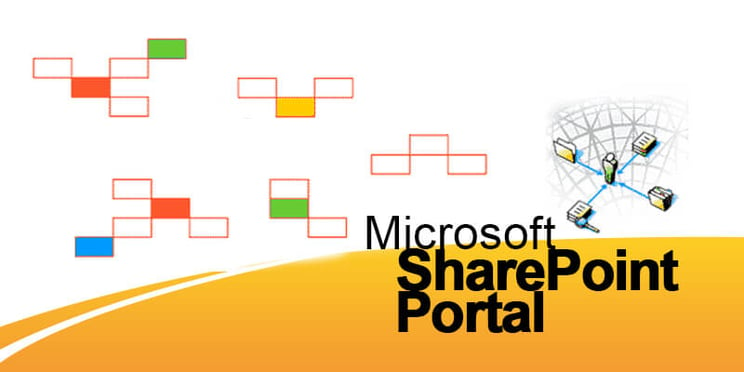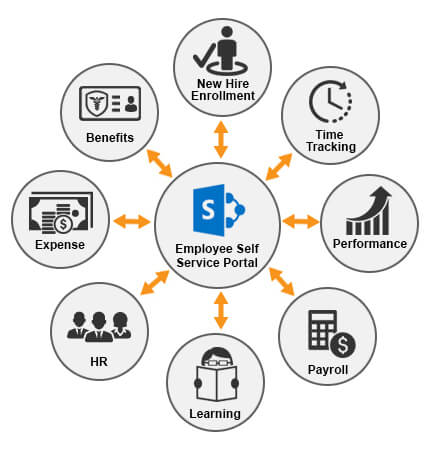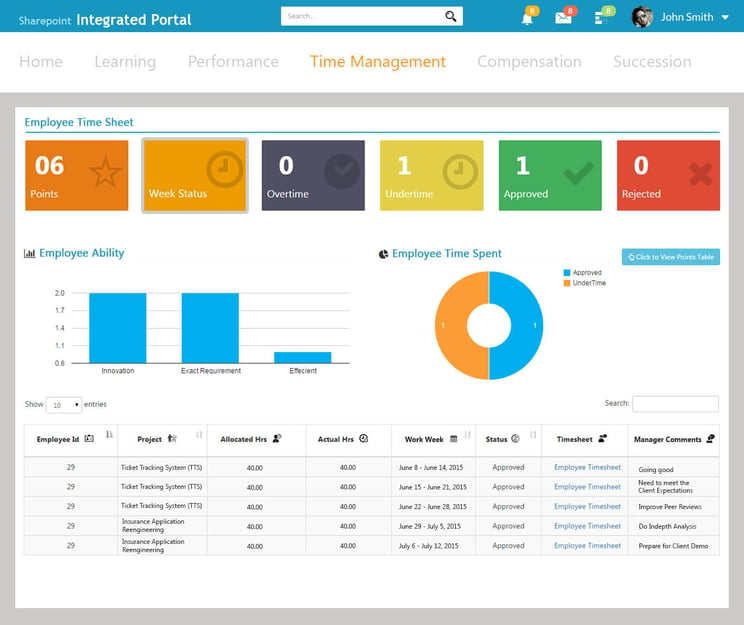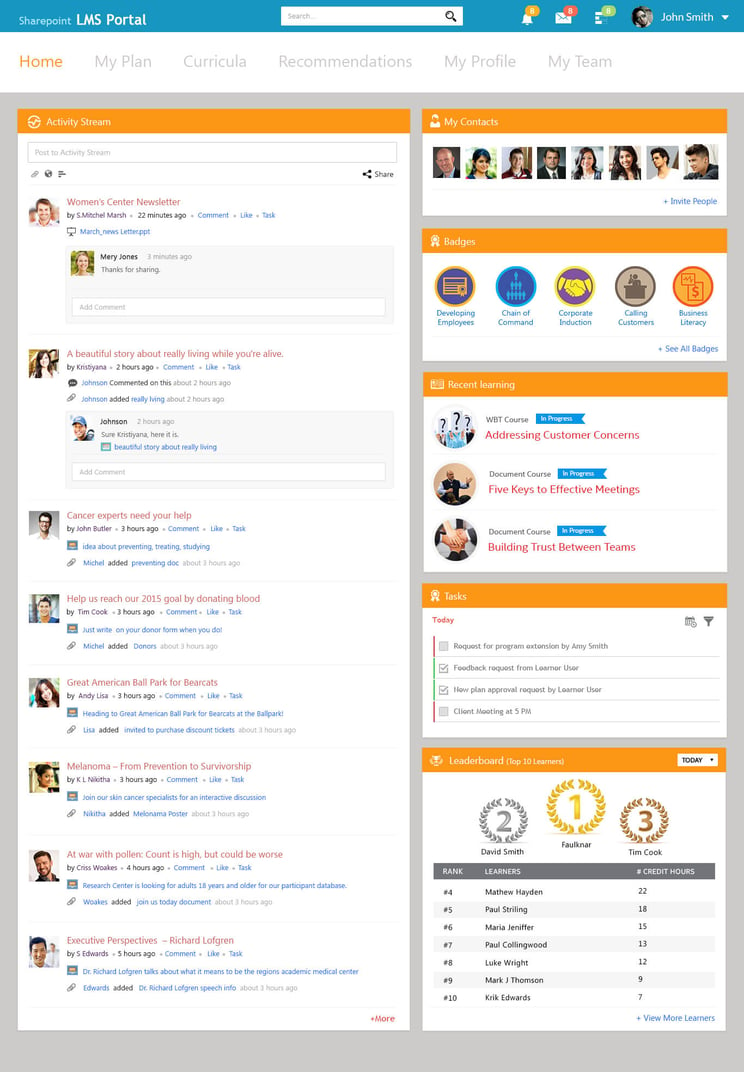
Microsoft SharePoint is one of the most widely used platforms for portals and employee collaboration within enterprises. Its extensive range of potentialities to manage content, business process, search tools, projects and team collaboration has become highly reliable for easy and efficient workflow in today’s enterprises. SharePoint portal allows better visibility into day to day processes, apart from being simply deployable, customizable and scalable. Its key strength lies in its flexibility to meet wide arena of enterprise needs.
We have observed lately lot of requests from our client base with regards to employee self-service portals, Talent portals, HR portals. There is a significant shift across different organizations to deliver effective, quality and innovative services offered by HR as the highest number of millennials in the workforce are looking for internet based user experience even within the enterprise.
Challenges for Human Resource Professionals:
- Human resources content, data and transactions are present in different applications and it is very hard to maintain the consistency and reliability of data between different areas.
- Personalization of content based on employee events or actions.
- Due to complexity of the organization and services offered to employees ranging from benefits, perks, expenses, leaves, resources and training. It’s a daunting task for HR to manage these different applications to deliver their job.
- Challenges with globalization of HR landscape.
- Employee’s expectations on more user friendly and real time availability of information.
Self-Service portals built using SharePoint helps in managing employee services such as Onboarding, benefits enrollment, Time, attendance, travel, expense, timesheets, learning, performance, leave, change & purchase requests and much more. It transforms your processes with appropriate work flow and also meets your compliance needs. From an Intranet/Internet portal employees can submit forms and check status of the progress of their requisitions. With approval workflow and roll-up reports by division and department. Employees and managers are kept up to date on approvals with appropriate triggers and notifications. Successful integrations between the different systems enhances the scope of your business offering a competitive advantage.
 SharePoint for Employee Self Service Portals:
SharePoint for Employee Self Service Portals:
Employee Onboarding requires a combination of multiple forms, documents, tasks and workflows—a process that can be daunting for both HR and employee. Integrating the different areas of onboarding into SharePoint would add value to the overall process.
- Initiating the requisition process with different groups within the company and appropriate approval workflows.
- Custom Welcome message from President, executives and managers.
- Managing new hire enrollment paperwork and enrollment forms.
- Introducing employee to company vision, culture and team.
- Availability of documents and resources for the employee to deliver his responsibilities.
With robustness of features, collaboration and communication between different stakeholders, it allows HR to deliver efficiency in their services.
Integration of new hire open enrollment processes into your SharePoint portal allows your employee to pick the options that are specific to their needs. Regulating employees access to their benefits and access to the required documents and managing end to end enrollment process inside the portal adds value both to employees and as well as HR and also reduce interpretation nightmares.Easy collaboration between employees, HR partners and vendors enhances the overall experience of your employees.
Integration of Employee expenses and e-forms into SharePoint allows you to create any kind of form with an easy to use, drag and drop user interface. Employees can complete the forms online, upload receipts or other supporting documents to the reimbursement form. With a single click, the form and all of the related documents are routed electronically to everyone in the workflow. Once approved, it can be routed to the accounts payable or run reports or exported to another source for payment processing outside of the portal. It also helps you to take control of your documents and to easily manage them by filing/storing the digital copies in a secure manner.

SharePoint for Learning Management System: CLO’s, Training managers are exploring alternatives to enhance the experience of their learners. Learning is becoming more Social, informal, blended and just in time. Integrating your corporate LMS into SharePoint will enhance your user experience and performance and reduces administrative burden with centralized management, customization, increased collaboration, consolidated sites, security and integrity and employee empowerment.
The integration of SharePoint with an LMS lightens the burden of the employees and the HR
- The monitoring of the learning becomes easy as employees can collaborate instantly without switching into different systems to manage different tasks.
- Administrative burden of managing vast documents becomes effortless as SharePoint holds all content in a secure way.
- Employees are acquainted with interactive learning as they collaborate at work to learn the essentials of high performing.
- You can make your SharePoint portal social and also have features for employee engagement.
- With integration of learning assets like courses, books, videos, Job aids and knowledge bases articles into one single platform, enhances the value for the organization and also helps to mining of the data efficiently.

Successful integrations with SharePoint brings in maximum ROI
A SharePoint Portal delivers all of the features and functionality, your organization needs, to improve employee satisfaction and service delivery; provides robust communication and reduces overall costs.
There are several advantages in using SharePoint for human resources:
- Consistency of the user experience. Employees can search and navigate the same way whether they are on their corporate intranet or on the portal, creating a true, seamless intranet.
- Truly integrated content. Think about it — HR content made available in places where employees already interact, instead of pushing employees to a place where only HR content resides or integrating an online calendar with Outlook. This level of integration is only manageable when all content resides on the same platform.
- Managing content. SharePoint’s content management works exactly the same way whether or not the content is HR-related. This lowers training and support costs, lessens time spent enabling proficiency in content management and the ability to use existing SharePoint training for HR.
- A single robust search engine. Employees don’t have to choose which site to search — HR applications or the corporate intranet. They simply search and obtain the same relevant results every time.
- IT support. When there are occasions when HR needs to work out of the enterprise solutions, then SharePoint Portal is a solution everyone can agree on. Even if an organization isn’t ready for an enterprise implementation of SharePoint, a SharePoint Portal for employees can initially be deployed as a stand-alone solution, and easily integrated into the enterprise when the time is right.
- All the other hosted or on premise applications can be accessed through a SharePoint portal and only a genuine SharePoint portal uses SharePoint’s award-winning features and functionality, and can integrate with existing and future enterprise implementations of SharePoint.
As organizations strive to create portals that align with their processes and strategies and provide a more Internet-like experience for employees, new hires, recruits and retirees, SharePoint is the optimal platform. SharePoint delivers all the capabilities and functionality required to achieve an effective, highly personalized, engaging and collaborative consumer-grade portal that can naturally integrate within your enterprise and be self-maintained.


